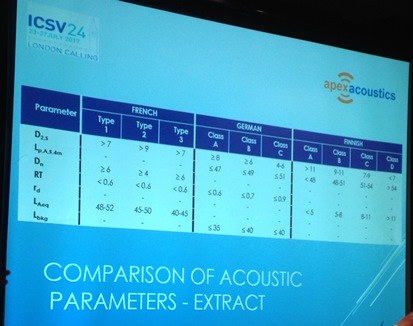
This summer the 24th International Congress on Sound and Vibration (ICSV24) was held in London (23 – 27 July 2017), and many specific acoustic sessions took place. I already published a general blog post about it, but in this one I would like to dive into the world of office acoustics.
Talking about office acoustics most of the time means more or less talking about the open-plan office and its acoustic challenges. Below I compiled some main content from the various office related ICSV London conference presentations and papers. My intension is to gather the new knowledge of office acoustics, thus facilitating for the Acoustic Bulletin readers who have this particular interest. All ICSV conference abstracts can be found here.

Practical trouble shooting and investigations
TROUBLE SHOOTING IN AN OPEN PLAN OFFICE: CASE STUDY (#52 T11 SS7)
Asselineau Marc*, Gaulupeau Aline, France
Interesting case where a telecom company reorganized one of its regional branches and the new layout called for open plan office. People soon complained of noise issues. The management decided to call an acoustician for investigations and noise control advice. Acoustic measurements were performed and discussions with the workers. For example the cleaning service staff was positively accepted but noise that did not go unnoticed was that of the toilets. The hissing noise from high pressure water that was heard all over was not in line with comfort. Two noisy locations were found: toilets and printers. The use of noise barriers much more as a border marker than as a noise reduction device was applied, together with advice on human behaviour.
SPEECH PROPAGATION IN OPEN-PLAN OFFICE: A CROSS OVER DESIGNED FIELD STUDY (#1141 T04 RS2)
Davidsson Frans, Hodsman Paige*, Sweden
The ISO standard 3382-3 for Open Plans was released 2012, looking at the speech propagation. This study investigates real office conditions, not controlled conditions, by isolating the sound environment in the manipulation. The study shows the importance of focusing on the acoustical conditions in open-plan offices in order to improve employees’ well-being and through means of that also organizational efficiency. Results suggest that even small deterioration in room acoustical properties measured by the new ISO standard for open-plan room acoustics; have a negative effect on self-rated indicators of both health and performance.
Sound masking – using water
AUDIO-VISUAL PREFERENCES OF WATER FEATURES USED IN OPEN-PLAN OFFICES (#186 T11 SS7)
Abdalrahman Zanyar*, Galbrun Laurent, United Kingdom
This paper examines the use of water generated sounds as a mean of masking irrelevant speech and improving the sound environment in open-plan offices. Water sound is a natural sound that has inherent positive qualities and physical properties that make it a potential noise masker. Six water features were selected as representative of a variety of designs that could be installed in an open-plan office.

Office productivity
REVIEW OF THE WORKS ON THE EFFECT OF SOUND ON OFFICE PRODUCTIVITY (#214 T12 SS2)
Mak Cheuk Ming*, Wong Hai Ming, Kang Shengxian, Ou Dayi Hong Kong
Noise in offices is related to an employee’s comfort, health and productivity. This paper re-viewed two recent works on office productivity. For one piece of work a seven-part questionnaire survey was conducted in 38 Hong Kong offices. It was found that sound and temperature were the main factors affecting office productivity. The most irritating noises were conversations, ringing phones and machines. The environment mattered least to the younger participants and female workers were found to be more sensitive to the environmental and office design factors. An office worker who is not satisfied with the sound environment in the office is more likely to have low office productivity.
For another piece of work a questionnaire was conducted by office workers in university open-plan research offices from nineteen universities in China. Office productivity was affected by the key Indoor Environmental Qualities aspects, such as acoustic environment. The lower productivity participants were more likely influenced and distracted by the noises of conversation, entertainment, phone ringing, door closing, footsteps, human activity, and keyboard sound.
New methods
PROPOSED METHOD FOR MEASURING LIVELINESS IN OPEN PLAN OFFICES (#296 T11 SS7)
Vellenga-Persoon Sara*, Hongens Theodoor, Bouwhuis Tom, Netherlands
ISO 3382-3 provides guidelines for measuring room acoustics in open plan offices. However, the actual behavior of people is often not considered in defining the acoustic environment of the open plan office environment. Since sound can have both a positive and a negative influence on people’s comfort and performance, the term ‘Liveliness’ is introduced as a relatively objective quantity. It comprises four labels, going from ‘Quiet’ via ‘Tranquil’ and ‘Lively’ to ‘Turbulent’.
Since many open plan offices are designed to have designated zones for certain types of work, especially since the introduction of Activity Based Working (ABW), it becomes easier to make a general assumption about the acoustical quality of a certain zone. Sound levels are expected to be low and constant in zones that are meant for focused work, whereas interactive areas should facilitate exchange of information with high sound levels and a lot of fluctuation.

Acoustical standards
COMPARISON OF OPEN PLAN OFFICE DESIGN IMPLICATIONS OF DIFFERENT NATIONAL STANDARDS (#641 T11 SS7)
Harvie-Clark Jack, Larrieu Felix*, Dobinson Nicholas, United Kingdom
Acoustic conditions in open plan offices have come under close scrutiny. Noise is one of the top causes of dissatisfaction and loss of productivity in the workplace, and the psychological impact of noise is the main cause of concern. This paper uses a new generic open plan office as a case study to investigate the design implications of the different national approaches to acoustic conditions in open plan offices. The implications of the Finnish, French and German standards for open plan office acoustics are compared. This paper illustrates the direct acoustic and interior design implications that vary significantly between different country guidelines.
Speech transmission
IRRELEVANT SPEECH EFFECT IN OPEN PLAN OFFICES: A LABORATORY STUDY (#988 T11 SS7)
Kostallari Krist*, Parizet Etienne, Chevret Patrick, Amato Jean-Noël, Galy Edith, France
It seems now accepted that speech noise in open plan offices is the main source of discomfort for employees. This work follows a series of studies based on Hongisto’s theoretical model (2005) linking the Decrease in Performance (DP) and the Speech Transmission Index (STI). The experiment that was carried out aimed to gather more information about the relation between DP and STI, varying the STI value up to 0.9. Results show a significant effect of the STI on the DP, the mental load and the discomfort. Furthermore, a significant correlation was found between the age of subjects and their performance during the Working-Memory task. General results did not show any increase of DP for the highest STI values, so the “plateau” hypothesis of Hongisto’s model cannot be rejected on the basis of this experiment.

Psychoacoustics
A PSYCHOLOGICAL APPROACH TO RESOLVING OFFICE NOISE (#1142 T04 RS2)
Davidsson Frans, Hodsman Paige*, Oseland Nigel, Sweden
Traditionally, control of noise in buildings falls into the domain of acousticians – experts concerned with the properties of sound. Although it is widely recognized that acoustics is an interdisciplinary science, many architectural acousticians have a physics or engineering background and their approach to mitigating noise is mostly, but not entirely, focused on physical solutions. But the demands of 21st-century workplaces call for a more rounded approach, with experts working together to offer a combined psychological, physiological and physical solution to acoustic problems.
This report therefore offers a fresh outlook to resolving noise distraction in the workplace based on a psychoacoustic, people-centered approach, focusing on perception, attitudes, mood, personality and behavior. The report is predominantly based on a literature review, with more emphasis on psychophysical research papers than pure acoustic ones.


